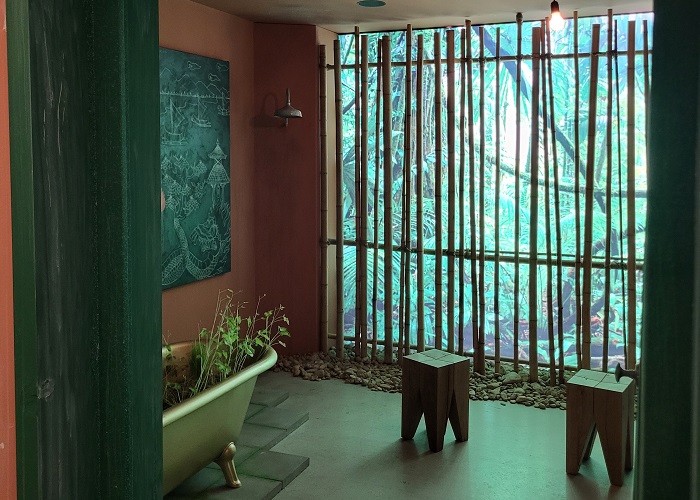
En anmeldelse af Bids for Survial: ROOTS af Michael Schindhelm
Postkolonialismens nuancer
Af Mikkel Bjørnskov-Bartholdy
/ English translation below article
14.10.2024
Kulturstiftung Basel H. Geiger |KBH.G har nu slået dørene op til det andet projekt i sit samarbejde med Michael Schindhelm. Træd ind i en verden af fordybelse, hvor udstilling møder installation i sin mest storslåede form, hvor din lugtesans, hørelse og berøring er en lige så stor del af den samlede oplevelse som dit syn.
Forestil dig Balis højland ved aftenstide. Varmen klæber endnu fugtigt til skumringsluften omkring dig, imens du nyder lyden af det jungleland, der omgiver dig. Duften af røgelse danser til de lokales rytmiske musik, der giver sagte genlyd fra rismarkerne i nærheden. Foran dig står en mægtig villa fra en svunden tid. Et nu forladt vidnesbyrd om masseturismens tidsalder, der skal udforskes. Hvert rum fyldt med kunstneriske oplevelser, hver væg dekoreret med farverige tegninger og malerier, der forkynder, hvad der var, hvad der er, og hvad der vil være. Historien udspiller sig foran dig som filmscener på lærredet af villaens fundament, alt imens du bevæger dig igennem ...
Forestil dig dette, og du har en god fornemmelse af, hvad denne udstilling handler om!
ROOTS er en mesterlig sammensmeltning af historie, kunst og kultur, behændigt orkestreret af forfatteren, filmskaberen og kuratoren Michael Schindhelm. Udstillingen ærer den gådefulde figur Walter Spies, alt imens den konfronterer den nuancerede arv af vestlig indflydelse og masseturisme på Bali, alt sammen inden for rammerne af et galleri. Resultatet er en tankevækkende, multisensorisk rejse, der bliver hængende længe efter du træder ud.
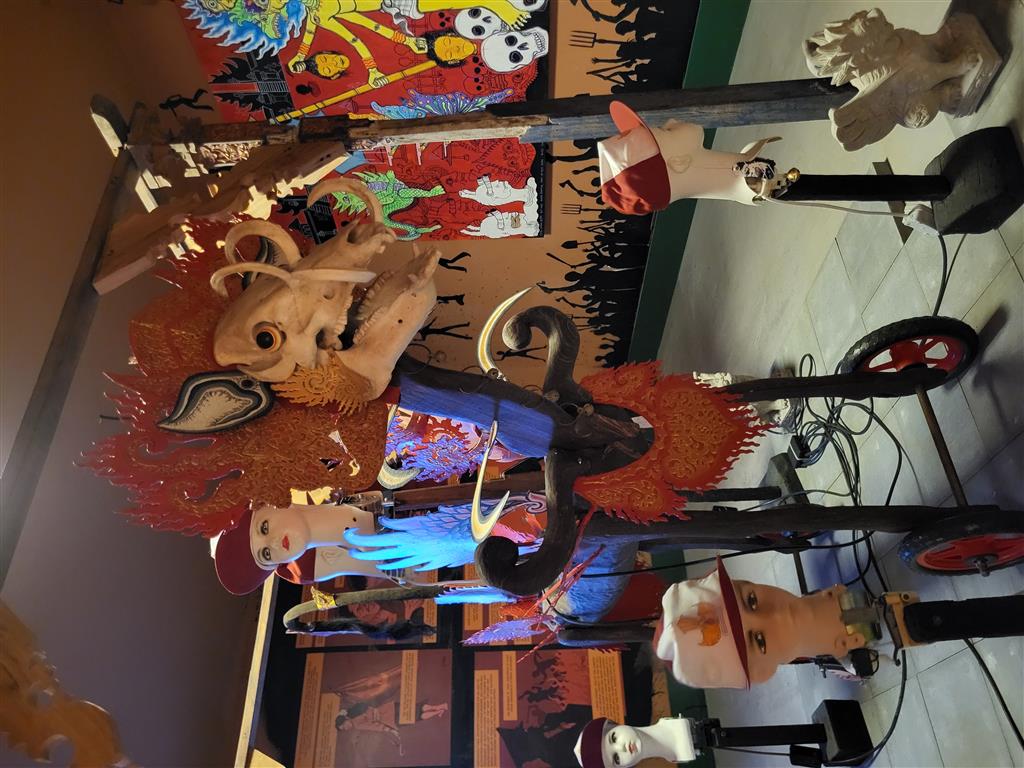
ROOTS - By Michael Schindhelm, “Living Room”, Kulturstiftung Basel H. Geiger, 2024. Foto Mikkel Bjørnskov-Bartholdy
Udforsk fortiden gennem nuet!
Schindhelms projekt på Kulturstiftung Basel H. Geiger (KBH. G), er en dybdegående udforskning af de kulturelle krydsfelter mellem historie og identitet. Som anden del i den årelange serie Bids for Survival er denne udstilling en levende fortsættelse af Schindhelms engagement med temaer, hvis indhold og betydning spænder globalt.
Denne gang har Schindhelm valgt at dykke ned i den russisk-tyske kunstner Walter Spies (1895-1942) og dennes komplekse og nuancerede arv, i særdeleshed hans varige indflydelse på øen Bali, som selv er gældende den dag i dag. I hjertet af udstillingen ligger Villa Iseh, Spies' eget fristed på Bali, bygget af kunstneren selv i 1937, her præsenteret som et vidnesbyrd på- og en form for mikrokosmos af øens eget, skiftende kulturlandskab.
Ved omhyggeligt at genskabe Villa Iseh, dette rum af intimitet for Spies selv, inviteres alle besøgende ind i hjertet af Spies' kunstneriske verden. En verden, der senere blev kendt over hele kloden som en feriedestination for de rige og berømte, såsom David Bowie, Yoko Ono og Mick Jagger, hvilket til sidst gav anledning til den første rigtige masseturismeindustri. Og som sådan en verden, der blev grundlæggende for hele den balinesiske kulturs udvikling og balinesernes egen selvforståelse i dag.
Denne bedrift bliver kun endnu mere gribende ved Spies' konstante, spøgelsesagtige tilstedeværelse, der fremhæves gennem et virvar af uddrag fra Schindhelms egen doku-fiktionsfilm, der ligeledes dykker ned i indflydelsen fra Spies' arv på Bali. I Schindhelms filmiske skildring forsøger Spies selv at navigere det nutidige Bali, hvor han blandt andet kæmper for at forene sin egen arv og øens voksende kulturelle identitet.
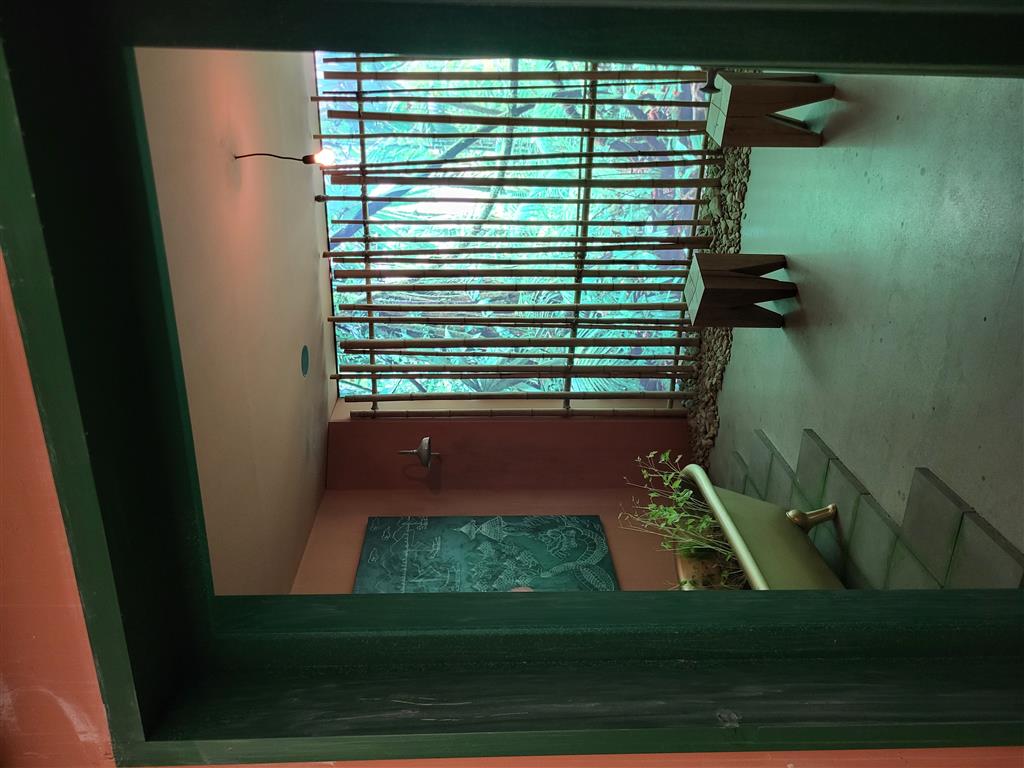
ROOTS - By Michael Schindhelm, “Bathroom”, Kulturstiftung Basel H. Geiger, 2024 - Foto Mikkel Bjørnskov-Bartholdy
Et dybt dyk ned i arven fra Spies
Schindhelms omhyggelige genskabelse af Villa Iseh - komplet med soveværelser, korridorer og endda et poolrum - tilbyder publikum en oplevelse, der inviterer til fordybelse, hvor man kan bryde med den traditionelle rolle som "den passive observatør", som mange har en tendens til at forbinde med dét at gå på galleri. Ved at bruge nogle få, overraskende enkle bekvemmeligheder gør denne udstilling et glimrende arbejde med at invitere sine gæster til at bebo sine rum, og til at føle og interagere med de historier, som den søger at skildre.
Spies' indflydelse på balinesisk kunst- og kulturliv er dyb, og ROOTS trækker denne indflydelse ind i en bredere fortælling om postkolonial kompleksitet. Ved at invitere bidrag fra balinesiske kunstnere som Made Bayak og Gus Dark sætter udstillingen et smukt fokus på øens nuværende kamp for at forme og bevare sin egen kulturarv i kølvandet på det, der dybest set var verdens første egentlige eksempel på masseturisme, og ikke mindst den kulturelle og miljømæssige krise, som fulgte i dennes fodspor. Disse kunstnere præsenterer, gennem stemningsfulde, visuelle og grafiske værker, Balis kulturelle identitet som et sted fuldt af både spænding og transformation.
Spørgsmål om natur og økonomi er temaer som gennemsyrer de fleste aspekter af denne udstilling, hvilket afspejler Schindhelms eget engagement for at adressere aktuelle globale tendenser. ROOTS præsenterer ikke kun Spies som en kunstner isoleret fra omverdenen, men som en figur, hvis arv er dybt sammenflettet med Balis realiteter, og ikke mindst befolkningens selvforståelse, især set i lyset af globalisering. Udstillingen stiller flere provokerende spørgsmål om kulturelt og identitetsmæssigt ejerskab og udnyttelse, såvel som kampen for at opretholde Balis egne traditioner.
Inklusionen af mørke øjeblikke i balinesisk historie, såsom folkemordet i 1965, giver en mere nøgtern og dyster baggrund for udstillingens bredere udforskning af kulturel identitet. Alt dette udfordrer beskueren til at overveje de dybere implikationer ved den postkoloniale historie, ikke kun på Bali, men i hele verden, såvel som de nuancerede påvirkninger, som turisme og vestlig indflydelse har haft på verden omkring sig.
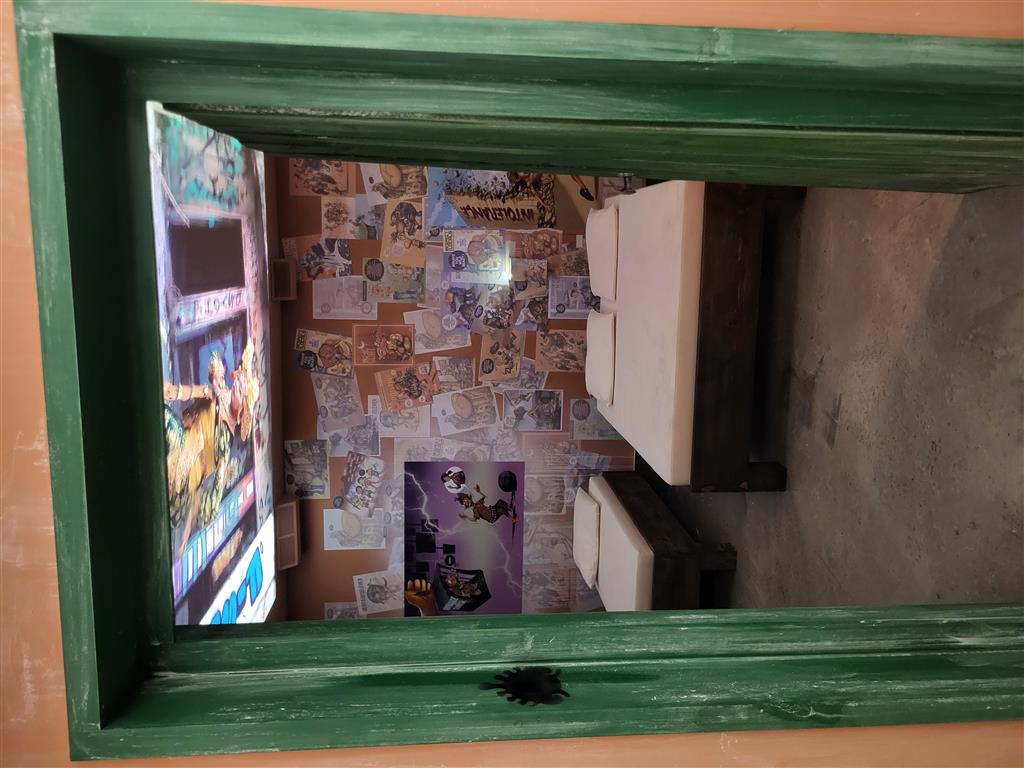
ROOTS - By Michael Schindhelm, “Bedroom”, Kulturstiftung Basel H. Geiger, 2024. Foto Mikkel Bjørnskov-Bartholdy
Bali i Basel?
ROOTS signalerer et markant skift i Basels kulturelle landskab. Som direktøren for KBH.G, Raphael Suter, selv bemærker, udvider udstillingen Basels egne historiske og kunstneriske arv og forbindelser, der selv er kendetegnet ved stor kulturel påvirkning fra omkringliggende stornationer, ved at forbinde byen med Bali.
Projektet går transcenderer blot at være en simpel hyldest til Spies eller Bali, og engagerer sig på denne vis i globale problemstillinger, som alle nationer og nationaliteter kan relatere til, samtidig med at det gentager seriens overordnede tema om overlevelse. Denne gang er det blot spørgsmålet om vores åndelige udholdenhed, snarere end nogen biologisk forevigelse, som bliver sat under luppen.
Et par afsluttende bemærkninger
For mig er et af udstillingens bedste træk dennes meget sansebundne historiefortælling. Jeg sætter pris på enhver oplevelse, der engagerer alle mine sanser på én gang, i stedet for ”bare” at lade mig observere. Det hjælper med at trække mig ind i en ægte følelse af nærvær. Denne oplevelse er ikke bare noget, du ser, du lugter den i luften, mærker den på din hud, og du rører ved den og lader den række ud og røre ved dig, engagerer sig i dig, alt imens du engagerer dig i den.
Sideløbende med Schindhelms film samler ROOTS en bred vifte af balinesiske bidrag fra dansere og koreografer til kunstnere og skuespillere, der alle bidrager med deres egen unikhed, krydret med en særlig følelse af Bali. Tilsammen skaber dette en levende hyldest til Spies, hvis kunstneriske arv gennemsyrer alle aspekter af hele oplevelsen. Denne fusion af dans, musik og malerkunst kanaliserer essensen af balinesisk tradition samtidig med, at den præsenterer nuancerne og kompleksiteten ved vestlig indflydelse, som skaber et rum til fordybelse, hvor fortid og nutid eksisterer side om side.
Hvis dette vækker din interesse, så kan jeg helhjertet anbefale et besøg!
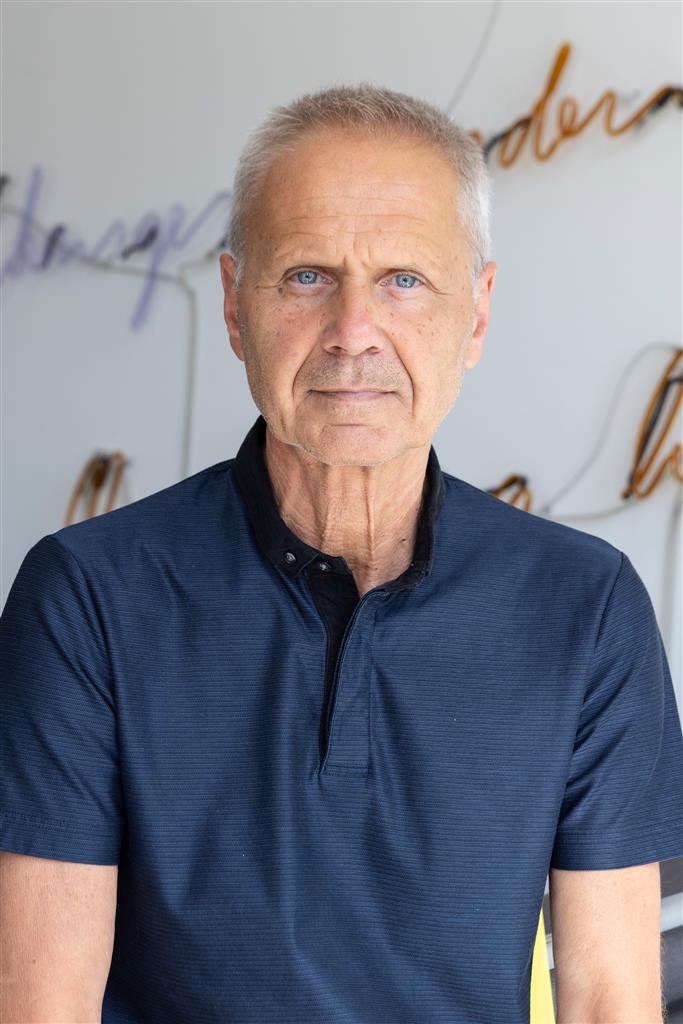
Portrait Michael Schindhelm. Photo: Kulturstiftung Basel H. Geiger KBH.G
Michael Schindhelm (født 1960) er en schweizisk-tysk kunstner, forfatter, filmskaber og kurator, bosat i Ticino. Siden han fik en kandidatgrad i kvantekemi tilbage i begyndelsen af 1980'erne, har Schindhelms lange og prestigefyldte portefølje som kunstner siden omfattet samarbejder med enheder fra Dubai Culture & Arts Authority (Dubai, UAE) og West Kowloon Cultural District (Hong Kong) til Strelka Institute (Moskva) og Zurich University of the Arts (Zürich).
I 2022 blev Schindhelm hædret med Herbert Quandt Media Prize, og hans 6. dokumentarfilm In the Mood for Art indbragte ham den gyldne fjer fra Swiss Associa on for Internal Communication i efteråret 2023.
Schindhelms interesse for Spies går mange år tilbage, og som sådan har ROOTS været et projekt flere år undervejs, og et projekt, der er meget kært og personligt for Schindhelm selv.
PRAKTISKE OPLYSNINGER
Bud på overlevelse af Michael Schindhelm
The End of Aging: 3. maj til 21. juli, 2024
ROOTS: 30. august til 17. november, 2024
Kulturstiftung Basel H. Geiger / KBH.G
Spitalstrasse 18,
4056 Basel, Schweiz
Åbent alle dage (undtagen tirsdag) fra kl. 11 til 18
Entré er gratis
Billedet øverst: ROOTS - By Michael Schindhelm, “Bedroom”, Kulturstiftung Basel H. Geiger, 2024. Foto Mikkel Bjørnskov-Bartholdy
ENGLISH TRANSLATION
The Nuance of Post-Colonialism
A review of Bids for Survial: ROOTS by Michael Schindhelm
By Mikkel Bjørnskov-Bartholdy
The Kulturstiftung Basel H. Geiger |KBH.G has now opened the doors to the second project in its collaboration with Michael Schindhelm. Enter a world of immersion, where exhibition meet installation in its grandest form, where your sense of smell, hearing and touch is as big a part of the total experience as your sight.
Imagine an evening in the highlands of Bali. The heat still clings damply in the air as you take in the sounds of the vast jungles that surround you. The smell incense dance to the rhythmic music of the locals that echoes up from the rice fields nearby. Before stand a mighty villa of a foregone age. A now desolate testimony of mass tourism to be explored. Every room filled with artful experiences, every wall decorated with colourful drawings and painting that herald what was, what is and what will be. History plays before you as scenes of cinema on the canvas of the villa’s foundation as you make your way through…
Imagine this and you get a good sense of what this exhibition is all about!
ROOTS is a masterful convergence of history, art, and culture, deftly orchestrated by the author, filmmaker, and curator Michael Schindhelm. It honors the enigmatic figure of Walter Spies while confronting the nuanced legacy of Western influence and mass tourism in Bali, all within the immersive setting of a gallery. The result is a thought-provoking, multi-sensory journey that lingers long after the exhibition ends.
Exploring the past through the presence!
Schindhelm's immersive project at the Kulturstiftung Basel H. Geiger (KBH.G), is a deeply layered exploration of cultural intersections, history, and identity. As part of the year-long series Bids for Survival, this exhibition is a vibrant continuation of Schindhelm's engagement with globally resonant themes.
This time around, Schindhelm has chosen to delve into the complex legacy of the Russo-German artist Walter Spies (1895–1942) and his enduring impact on the island of Bali even to this day. At the heart of the exhibition lies Villa Iseh, Spies’ sanctuary in Bali, built by the artist himself in 1937, here presented as a testimony to the microcosm of the island’s shifting cultural landscape.
By carefully recreating this villa, this space of intimacy for the artist, visitors are invited into the heart of Spies’ world. A world that later became renowned around the world as a holiday destination for the rich and famous, such as David Bowie, Yoko Ono, and Mick Jagger, eventually giving rise to the first true industry of mass tourism. And as such, a world that became fundamental for the present-day development of Balinese culture and Balinese’s own sense of self.
This feat is only made more poignant by the constant, spectral presence of Spies himself, brought to life through ever present excerpts from Schindhelm’s own docu-fiction film that likewise dive into the influence of Spies’ legacy on the Balinese people. In this cinematic portrayal, Spies navigates a contemporary Bali, struggling to reconcile his own legacy and the island's evolving cultural identity.
A deep dive into the legacy of Spies
Schindhelm's meticulous recreation of Villa Iseh - complete with bedrooms, corridors, and even a pool room - offer the audience an immersive experience where they can transcend the traditional role of “the passive observer” that many tend to connect with going to the gallery. By utilising a few surprisingly simple comforts, this exhibition does a good job at inviting its guests to inhabit its space, to feel and interact with it and the stories that it seeks to portray.
Spies’ influence on Balinese modernism is profound, and ROOTS places this influence within a broader narrative of postcolonial complexity. By inviting in and showcasing contributions by Balinese artists such as Made Bayak and Gus Dark, the exhibition deftly highlights the island’s ongoing struggle to mould and preserve its cultural heritage in the face of what was basically the world’s first true case of mass tourism, and not least the environmental degradation that has followed in its footsteps. These artists, through evocative visual and graphic works, present Bali’s cultural identity as a site of tension and transformation.
Environmental and economic issues and themes penetrate most aspects of this exhibition, reflecting Schindhelm’s commitment to addressing the current global trends. ROOTS does not merely present Spies as an artist in isolation but as a figure whose legacy is deeply intertwined within Bali’s ecological and economic realities, and not least its populaces sense of self, especially in the face of globalization. The exhibition poses several provocative questions about cultural and identical ownership, exploitation, and the struggles to sustain Bali’s own rich traditions.
The inclusion of pivotal moments in Balinese history, such as the genocide of 1965, provides a more sobering and sombre backdrop to the exhibition’s broader exploration of cultural exchange. These moments, alongside Schindhelm’s narrative, challenge the viewer to consider the deeper implications of postcolonial history, not just on Bali, but the world as a whole, as well as the ongoing transformations wrought by tourism and Western influence.
Bali in Basel?
ROOTS signals a significant shift in Basel’s cultural landscape. As Raphael Suter, Director of KBH.G, notes, the exhibition expands the foundations scope by linking Bali to Basel’s own historical and artistic connections. The project goes beyond a simple homage to Spies or Bali, engaging with global ecological and economic issues that everyone can relate too, while echoing the exhibition’s overarching theme of survival. This time around the concern is for our spiritual endurance rather than any biological perpetuation.
A few final remarks
For me, one of the exhibition’s most compelling features is its multi-sensory storytelling. I appreciate any experience that engages all my senses at once. It helps to force me into a true sense of presence. This experience is not simply something you see. You smell it in the air, feel it on your skin and you touch it and let it reach out and touch you, engage with you as you engage with it.
Alongside Schindhelm’s film, ROOTS brings together a wide range of Balinese collaborators - from dancers and choreographers, to artists and actors - each and all contributing their own uniqueness, sprinkled with a special sense Bali, to the creation of a living, breathing homage to Spies, whose artistic legacy permeates all aspects of the entire experience. This fusion of dance, music, and art channels the essence of Balinese tradition while presenting the nuance and complexities of Western influence, creating an immersive space where past and present coexist.
If this prospect piques your interest, then I can whole heartedly recommend a visit!
Michael Schindhelm (born 1960), is a Swiss-German artist, writer, filmmaker, and curator, residing in Ticino. Since earning a Master of Science in Quantum Chemistry back in the early 1980s, Schindhelm’s long and prestigious portfolio as an artist has since included collaborations with entities from Dubai Culture & Arts Authority (Dubai, UAE), and West Kowloon Cultural District (Hong Kong), to Strelka Institute (Moscow), and Zurich University of the Arts (Zurich).
In 2022, Schindhelm was honoured with the Herbert Quandt Media Prize, and his 6th documentary film In the Mood for Art earned him the Golden Feather from the Swiss Associa on for Internal Communication in the fall of 2023.
Schindhelm’s interest in Spies goes back many years, and as such ROOTS has been a project several years in the making, and a project that is very dear and personal to Schindhelm himself.






